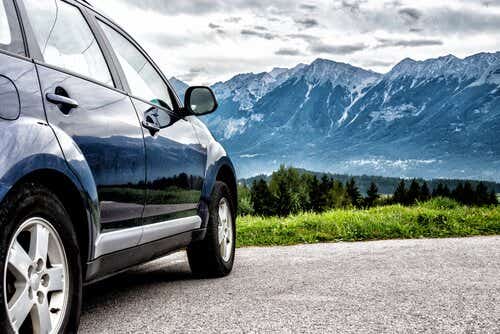What is European car insurance?
Most car insurance will provide some form of cover if you take your vehicle to Europe. But there can be a lot of differences in the extent of that cover.
Your policy will usually give you third-party insurance as a minimum when you drive on the Continent. This means you’re insured for damage you cause to other vehicles. However, on its own, third-party insurance won’t allow you to claim for damage to your own car, or if it is stolen. For that, you need comprehensive car insurance.
Some insurance policies provide full comprehensive European car insurance as standard, but in other cases you may need to contact your insurer and pay a fee to get extra cover. You should also check how long any European cover lasts. Some policies include full European car insurance but only for a certain period, for example 30 or 90 days. In this case, you will need to pay extra if your trip will last longer, or if you’re planning on making multiple visits.
You don’t have to get European cover from your current car insurance company. If you’d prefer, you can take out a separate temporary policy from another insurer. This could work out to be a cheaper option, so be sure to compare prices.
What documents do I need to drive in Europe?
It’s important to make sure you take the right documents with you on your trip. Some of them are likely to be a legal requirement in the countries you visit. The most important documents are:
- Your driving licence.
- Your vehicle’s log book (V5C certificate), which shows you are the registered owner.
- Evidence that your car is insured, such as a policy document or green card.
- Your passport.
- Travel insurance details.
When driving in EU countries, you also need a UK sticker on your car if your licence plate doesn’t have a Union flag on it.
Do I need a green card to drive in Europe?
A green card is a document that shows your car is insured to at least the minimum level when you’re driving in Europe. At the moment, you don’t need a green card to drive in most European countries. This includes European Union (EU) member states, as well as other non-EU countries like Andorra, Bosnia and Herzegovina, Iceland, Liechtenstein, Montenegro, Norway, Serbia and Switzerland.
However, you may need to carry a green card if you’re heading to Albania, Azerbaijan, Moldova, Turkey or Ukraine.
To get a green card, contact your insurance company.
What level of cover do I need to drive in Europe?
Wherever you’re headed in Europe, you’ll need to have at least third-party insurance in place. If you have a valid car insurance policy in the UK, this should automatically provide third-party cover in Europe. Third-party insurance only covers you for damage you cause to other vehicles. To get protection against theft and damage to your own car, you should get a comprehensive insurance policy.
Are there any restrictions on my cover?
While most car insurance policies automatically provide at least third-party cover if you take your vehicle to Europe, there is likely to be a time limit. This is usually between 30 or 60 days, but some insurers offer cover for a significantly shorter period so check before you go.
If you need cover for longer than the insurer is offering as standard, you may be able to pay to extend the policy.
Do I need breakdown cover when driving in Europe?
It’s not a legal requirement to have breakdown insurance when you take your car to Europe. But it makes sense to get a policy that can limit the costs and delays that could result from mechanical failure.
As with standard car insurance, make sure you shop around for the policy that offers the right level of protection at the right price.
It’s a legal requirement in many European countries to carry certain items with you at all times in case you break down. These include equipment such as high-vis jackets for everyone in the car and an emergency warning triangle. Before you go, check the specific requirements in each country you plan to visit.
Get a car insurance quote
See a range of car insurance quotes in just a few minutes when you compare with Uswitch
What else do I need to take when driving abroad?
There’s more to driving abroad than sticking to the other side of the road. Depending on where you're going, you might need to take some kit with you.
For example, the French require all drivers and their passengers to have high visibility jackets close to hand, as opposed to being packed away under a tonne of luggage in the boot. In Spain, Cyprus and Malta a GB sticker is a must, even if you have one on your number plate.
Each country will have its own list of requirements, which are subject to change, so it’s best to do a search before heading off and ensuring you have the right equipment.
To be on the safe side, pack the following, in addition to fitting a GB sticker to your boot and taking reflective jackets:
- a red warning triangle
- headlight convertors
- a first aid kit
- spare car lamp bulbs
- emission certificates (for certain cities – see environmentalbadge.com for more info)
Driving abroad and local driving customs
Each country has its own regulations that will be second nature to native motorists but might catch British holidaymakers out.
For example:
- you must park on a certain side of the street in some parts of Spain depending on the day of the week
- anyone driving in Romania or Russia can get a fine if caught driving a dirty car
Other customs that might result in a fine or worse include:
- Driving in Germany – it’s illegal to overtake school buses that have their hazard lights on
- Driving in Holland – buses have right of way when leaving a stop in built-up areas
- Driving in Macedonia – passengers who are visibly under the influence of alcohol can’t travel up front
- Driving in Portugal – it’s illegal to carry bikes on the back of a car
- Driving in Slovakia – proof of medical insurance is a requirement when entering the country
- Driving in Spain – drivers who wear glasses, and this is noted on their licence, should keep a spare pair with them
Police in most European countries are able to give on-the-spot fines or confiscate your car if you infringe their driving laws and fail to pay up, so it pays to be aware of local laws.
How old do you need to be to drive abroad?
Even if you have a full licence, your insurer may stipulate a minimum age and driving experience before they will consider you insured. This can be 18 or 21 years old, so check your policy. You will usually need to have held a full driving licence for at least six months.
Get a car insurance quote
See a range of car insurance quotes in just a few minutes when you compare with Uswitch




